Blood Type Punnett Square: Complete Guide to ABO Inheritance
Understanding how blood types are inherited through generations using Punnett squares - the essential genetic tool for predicting offspring phenotypes and genotypes.
What is a Blood Type Punnett Square?
A blood type Punnett square is a genetic diagram used to predict the probability of specific blood types in offspring based on parental genotypes. Named after British geneticist Reginald Punnett, this grid-based tool visualizes all possible combinations of alleles that parents can pass to their children.
For ABO blood types, Punnett squares help illustrate the inheritance patterns of the three key alleles (A, B, and O) and predict the resulting blood types (A, B, AB, and O) in offspring. These visual representations are invaluable for understanding codominance, multiple alleles, and dominant-recessive relationships in blood type genetics.
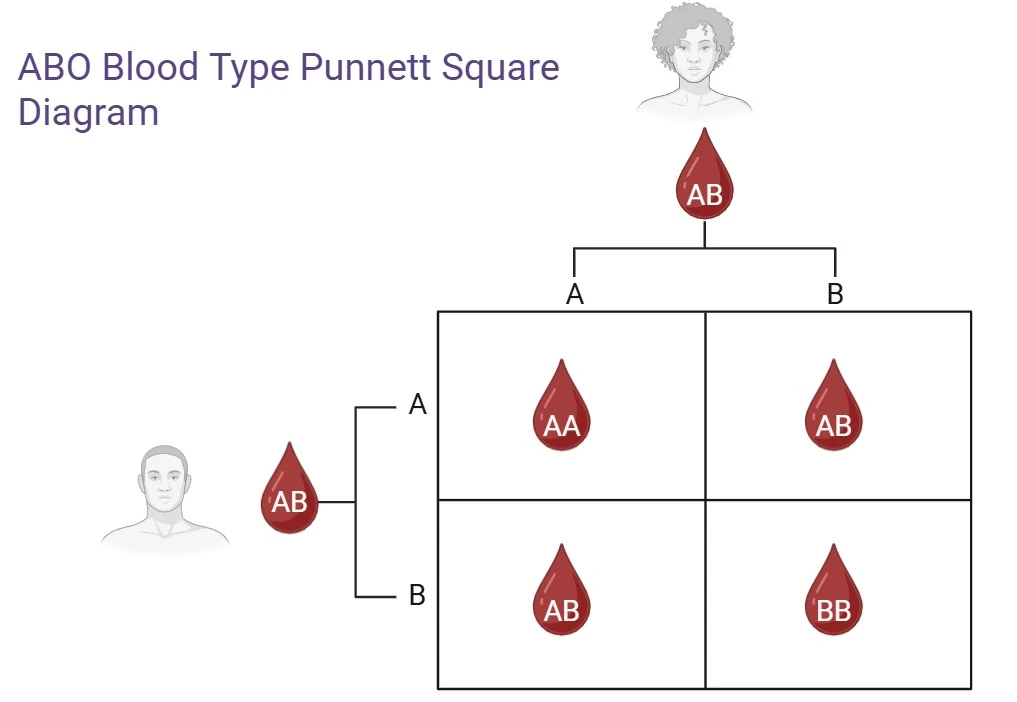
The ABO Blood Type System: Genetic Foundation
The ABO blood type system is determined by three alleles: A, B, and O. These alleles control the production of specific antigens on red blood cells.
- A allele: Produces A antigens
- B allele: Produces B antigens
- O allele: Produces no antigens
The six possible genotypes (AA, AO, BB, BO, AB, OO) result in the four phenotypes (blood types A, B, AB, and O).
ABO blood types follow specific inheritance patterns that can be visualized using Punnett squares:
- A and B alleles are codominant with each other
- Both A and B alleles are dominant over the O allele
- The O allele is recessive to both A and B alleles
- A person needs two O alleles (OO) to have Type O blood
The relationship between genotype and phenotype in ABO blood types:
Common Blood Type Punnett Square Examples
Example 1: Type A × Type O Cross
When a heterozygous Type A parent (AO) has children with a Type O parent (OO), the Punnett square shows a 50% chance of Type A offspring and a 50% chance of Type O offspring.
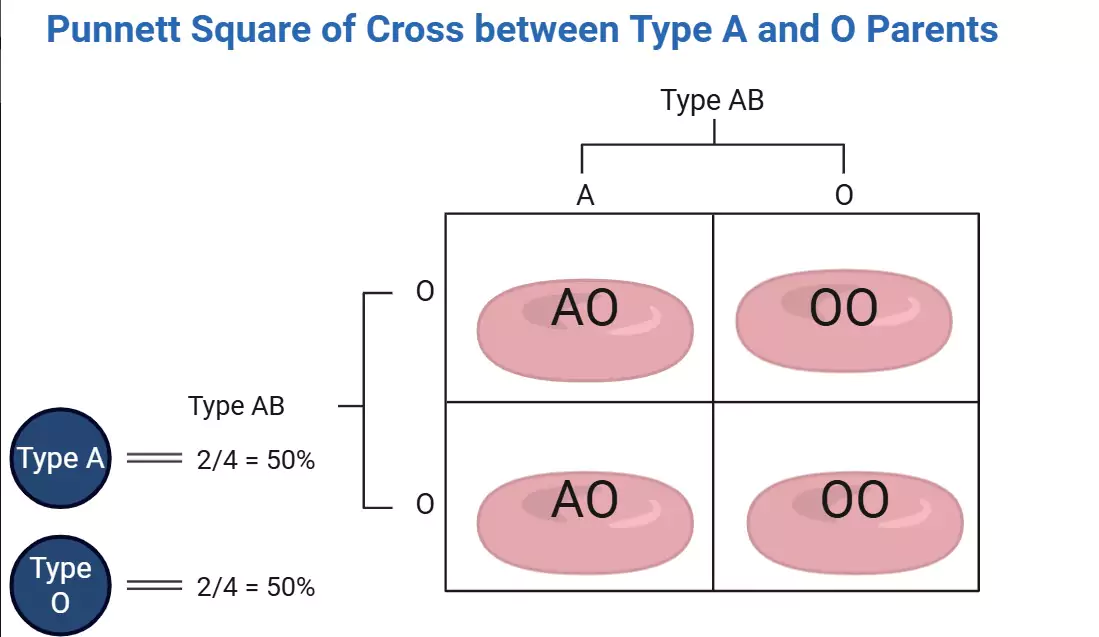
Parent Genotypes: AO × OO
Possible Gametes: A, O from first parent; O, O from second parent
Offspring Genotypes: 50% AO, 50% OO
Offspring Phenotypes: 50% Type A, 50% Type O
Example 2: Type A × Type B Cross
When heterozygous Type A (AO) and Type B (BO) parents have children, the Punnett square reveals the possibility of all four blood types in their offspring.

Parent Genotypes: AO × BO
Possible Gametes: A, O from first parent; B, O from second parent
Offspring Genotypes: 25% AB, 25% AO, 25% BO, 25% OO
Offspring Phenotypes: 25% Type AB, 25% Type A, 25% Type B, 25% Type O
Example 3: Type AB × Type O Cross
When a Type AB parent (AB) has children with a Type O parent (OO), the Punnett square demonstrates that all offspring will be either Type A or Type B, with no possibility of Type AB or Type O.
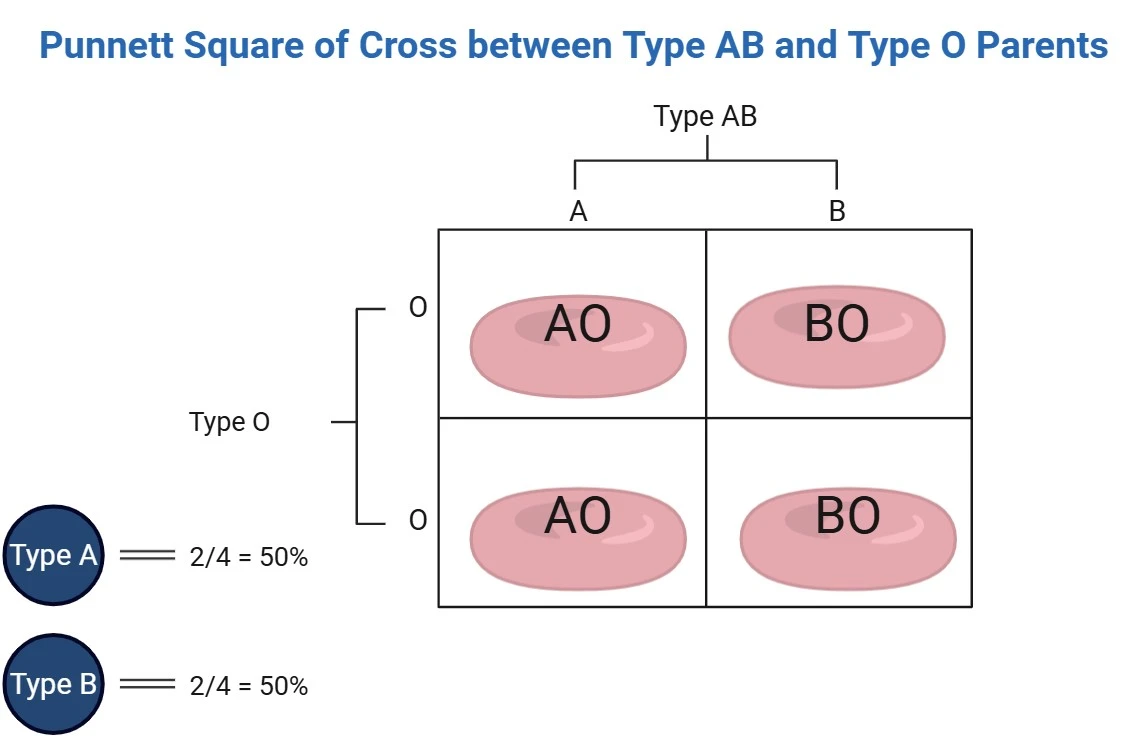
Parent Genotypes: AB × OO
Possible Gametes: A, B from first parent; O, O from second parent
Offspring Genotypes: 50% AO, 50% BO
Offspring Phenotypes: 50% Type A, 50% Type B
Example 4: Type AB × Type AB Cross
When two Type AB parents (AB) have children, the Punnett square shows that Type O blood is impossible in their offspring, as neither parent carries the O allele.
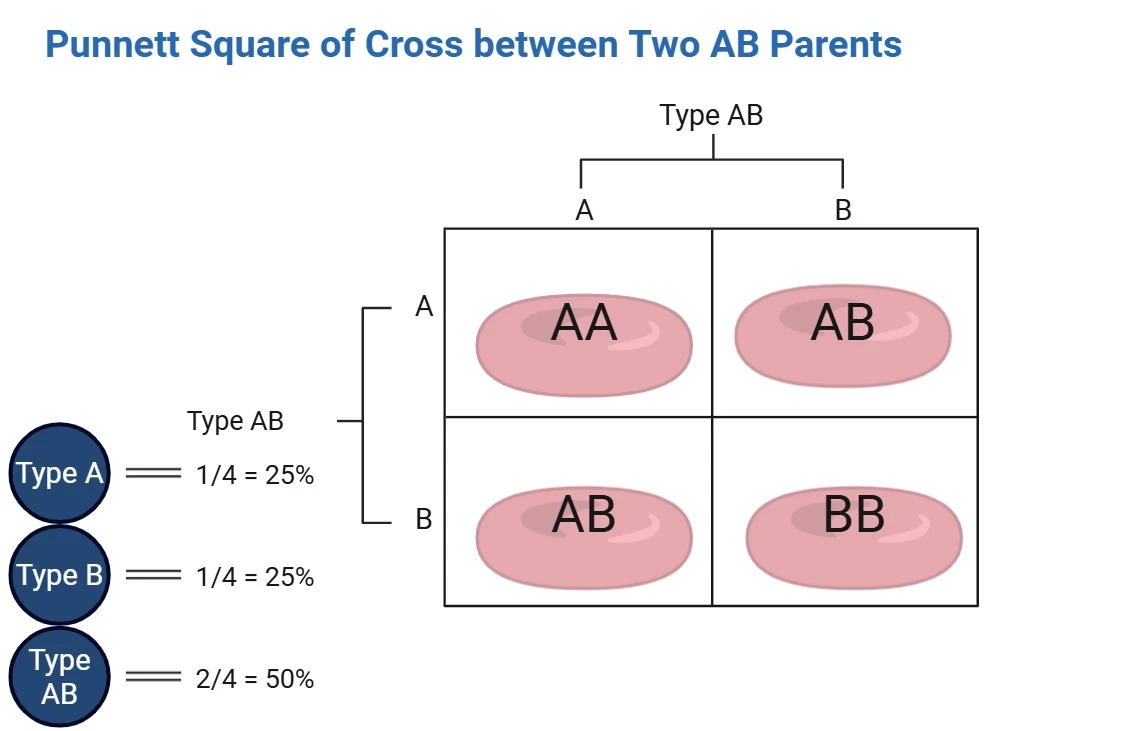
Parent Genotypes: AB × AB
Possible Gametes: A, B from both parents
Offspring Genotypes: 25% AA, 50% AB, 25% BB
Offspring Phenotypes: 25% Type A, 50% Type AB, 25% Type B
Special Cases and Genetic Exceptions
The Bombay phenotype (hh) is a rare blood type where individuals cannot express A or B antigens even if they have A or B alleles. This occurs due to a mutation in the H gene, which is necessary for ABO antigen expression.
In Punnett squares involving the Bombay phenotype, individuals appear to have Type O blood regardless of their ABO genotype, creating apparent exceptions to standard inheritance patterns.
The cis-AB allele is a rare genetic variant where a single allele codes for both A and B antigens. This creates inheritance patterns that appear to violate Mendelian genetics when traditional Punnett squares are used.
For example, a person with one cis-AB allele and one O allele will have Type AB blood, but can pass either the cis-AB allele or the O allele to offspring, resulting in either Type AB or Type O children.
Subgroups of A and B blood types (like A₁, A₂, B₁, B₂) can complicate Punnett square predictions. These variants produce different amounts of antigens and can sometimes be difficult to detect in standard blood typing.
When creating Punnett squares with these subgroups, additional notation is needed to accurately predict the phenotypes of offspring, as the expression of antigens can vary in strength.
Advanced Applications of Blood Type Punnett Squares
Paternity Testing
Blood type Punnett squares can be used to exclude potential fathers in paternity cases. While not as definitive as DNA testing, blood type analysis can quickly rule out impossible paternal relationships.
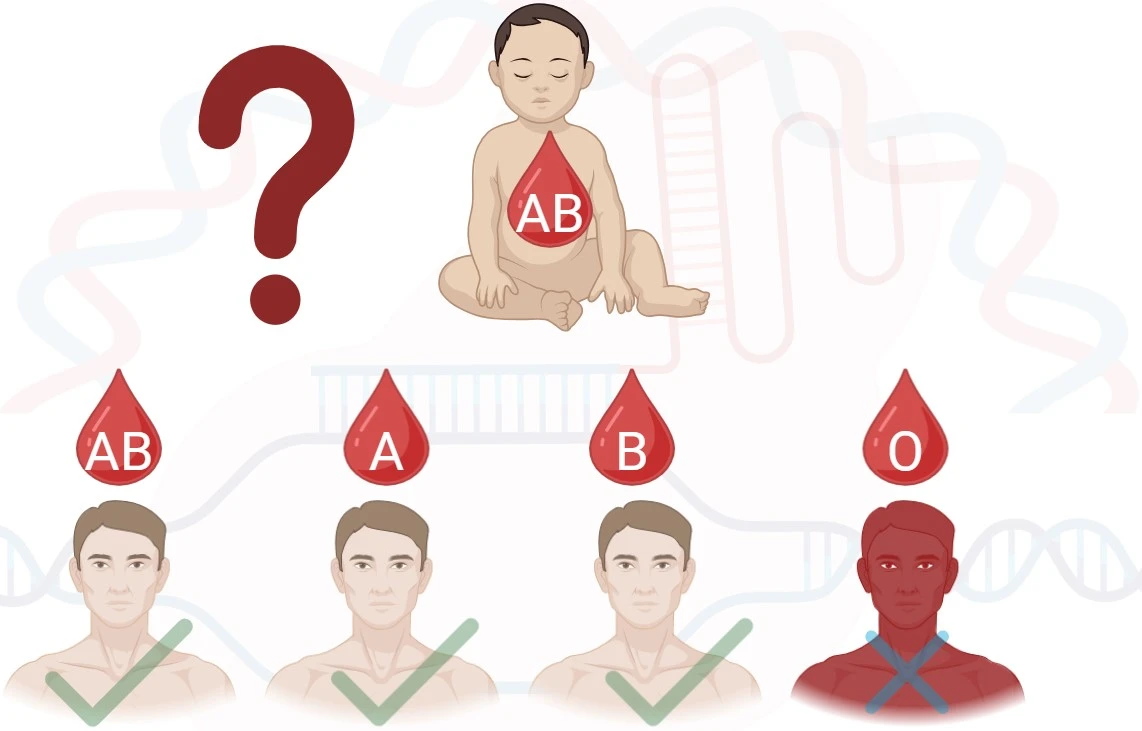
For example, if a child has Type AB blood, the biological father must have either Type A, Type B, or Type AB blood—a man with Type O blood cannot be the biological father. These exclusions can be clearly demonstrated using Punnett squares.
Population Genetics
Blood type Punnett squares, combined with Hardy-Weinberg equilibrium calculations, help geneticists study the distribution of ABO alleles in different populations around the world.
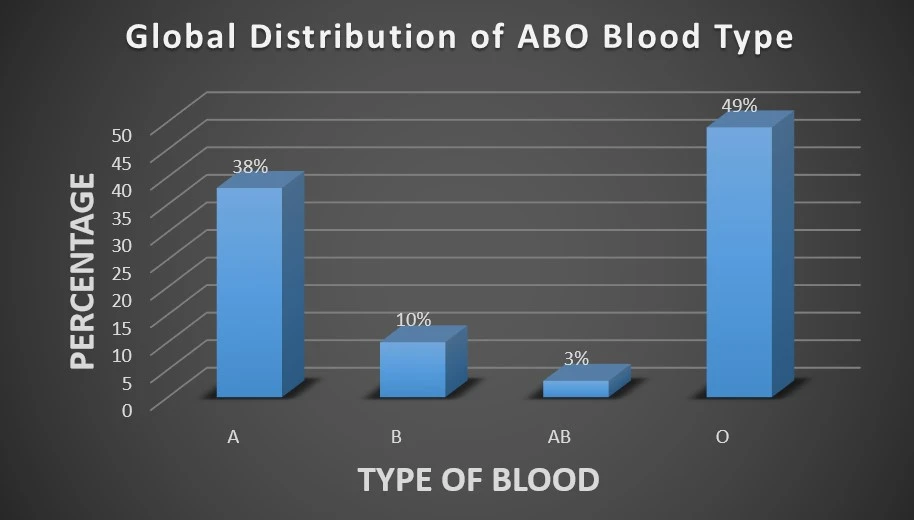
These studies reveal fascinating patterns: Type O is most common globally (45-50%), Type A predominates in Northern Europe, Type B is more prevalent in Central Asia, and Type AB is the rarest worldwide (1-5%). Punnett squares help explain how these distributions remain stable or change over generations.
Educational Value of Blood Type Punnett Squares
Blood type Punnett squares are ideal for teaching fundamental genetic concepts because they demonstrate:
- Multiple alleles (A, B, O)
- Codominance (A and B alleles)
- Complete dominance (A and B over O)
- Genotype vs. phenotype relationships
- Probability in inheritance
These squares provide a visual framework that helps students grasp abstract genetic principles through a familiar, real-world example.
Healthcare professionals use blood type Punnett squares for:
- Genetic counseling for expectant parents
- Predicting Rh incompatibility risks
- Understanding transfusion compatibility
- Explaining inheritance to patients
Medical students learn to create and interpret these squares as part of their training in genetics and hematology, applying theoretical knowledge to clinical scenarios.
Blood type Punnett squares enhance scientific literacy by:
- Connecting abstract genetics to personal health
- Demonstrating the predictive power of science
- Illustrating how probability applies to biology
- Showing how genetic traits are inherited
This accessible example of genetic inheritance helps the general public understand more complex genetic concepts and appreciate the role of genetics in their lives.
Historical Context of Blood Type Genetics
Discovery and Development
The ABO blood group system was discovered by Karl Landsteiner in 1901, earning him the Nobel Prize in Physiology or Medicine in 1930. The genetic basis of blood types was later elucidated by Felix Bernstein in 1924, who proposed the three-allele model.
Reginald Punnett developed his eponymous square method around 1905 while working at Cambridge University. The application of Punnett squares to blood type inheritance became a cornerstone example in genetics education throughout the 20th century.
Today, blood type Punnett squares remain one of the most widely taught examples of Mendelian genetics, appearing in virtually every biology textbook and curriculum worldwide.
Key Historical Milestones:
- 1900-1901: Karl Landsteiner discovers the ABO blood group system
- 1905: Reginald Punnett develops the Punnett square method
- 1924: Felix Bernstein proposes the three-allele model for ABO inheritance
- 1930: Landsteiner receives the Nobel Prize for his blood group work
- 1990: The ABO gene is cloned and sequenced, confirming the molecular basis
Common Misconceptions About Blood Type Inheritance
Misconception #1: Type O parents can have a Type A, B, or AB child
Fact: Two Type O parents (both OO genotype) can only have Type O children. Any other blood type in a child would indicate non-paternity or a rare genetic mutation. Punnett squares clearly demonstrate this genetic impossibility.
Misconception #2: Type AB parents can have a Type O child
Fact: Two Type AB parents (both AB genotype) cannot have a Type O child because neither parent carries the O allele. Punnett squares show that their children will be Type A, Type B, or Type AB only.
Misconception #3: Blood type inheritance follows simple dominant-recessive patterns
Fact: ABO blood type inheritance involves both codominance (between A and B alleles) and complete dominance (A and B over O). This mixed inheritance pattern makes Punnett squares particularly valuable for accurate prediction.
Misconception #4: Blood type is determined by a single gene
Fact: While the ABO locus is the primary determinant, other genes (like the H gene) influence blood type expression. Standard Punnett squares typically focus only on the ABO gene, which is sufficient for most cases but doesn't capture the full genetic complexity.
Misconception #5: A child's blood type must match one of the parents
Fact: A child can have a blood type that neither parent has. For example, if both parents are Type A with genotype AO, they can have a Type O child (25% probability). Punnett squares help visualize these seemingly counterintuitive outcomes.
Misconception #6: Blood type inheritance is always predictable with 100% accuracy
Fact: While Punnett squares provide statistical probabilities, they cannot predict the exact blood type of any specific child. Each pregnancy is an independent event with the same probability distribution, regardless of previous children's blood types.
Misconception #7: Blood type O is always recessive
Fact: The O allele is recessive to both A and B alleles, but this doesn't mean Type O blood is rare. In fact, it's the most common blood type globally because many people carry the O allele. Punnett squares help demonstrate how recessive traits can be common in populations.
Misconception #8: Blood type determines all transfusion compatibility
Fact: While ABO compatibility is crucial, other factors like Rh factor (positive or negative) also determine transfusion compatibility. Punnett squares for blood type should include Rh factor for complete transfusion compatibility analysis.
